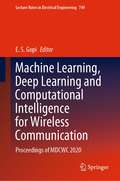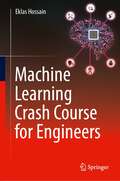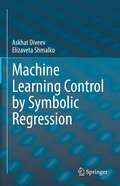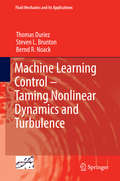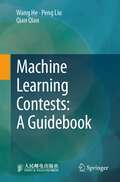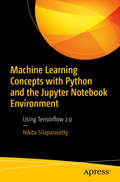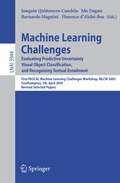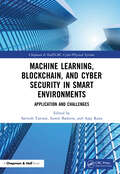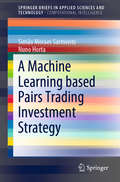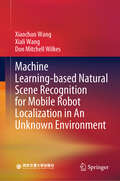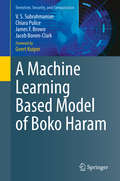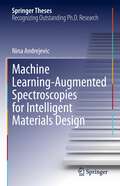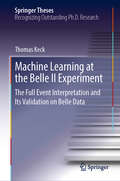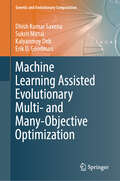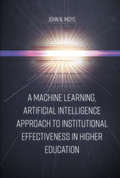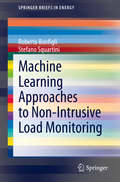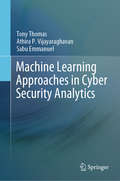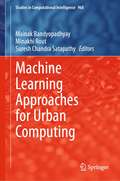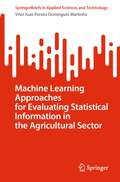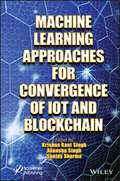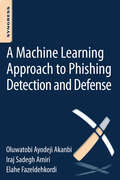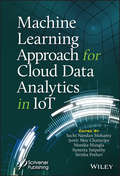- Table View
- List View
Machine Learning, Deep Learning and Computational Intelligence for Wireless Communication: Proceedings of MDCWC 2020 (Lecture Notes in Electrical Engineering #749)
by E. S. GopiThis book is a collection of best selected research papers presented at the Conference on Machine Learning, Deep Learning and Computational Intelligence for Wireless Communication (MDCWC 2020) held during October 22nd to 24th 2020, at the Department of Electronics and Communication Engineering, National Institute of Technology Tiruchirappalli, India. The presented papers are grouped under the following topics (a) Machine Learning, Deep learning and Computational intelligence algorithms (b)Wireless communication systems and (c) Mobile data applications and are included in the book. The topics include the latest research and results in the areas of network prediction, traffic classification, call detail record mining, mobile health care, mobile pattern recognition, natural language processing, automatic speech processing, mobility analysis, indoor localization, wireless sensor networks (WSN), energy minimization, routing, scheduling, resource allocation, multiple access, power control, malware detection, cyber security, flooding attacks detection, mobile apps sniffing, MIMO detection, signal detection in MIMO-OFDM, modulation recognition, channel estimation, MIMO nonlinear equalization, super-resolution channel and direction-of-arrival estimation. The book is a rich reference material for academia and industry.
Machine Learning Crash Course for Engineers
by Eklas HossainMachine Learning Crash Course for Engineers is a reader-friendly introductory guide to machine learning algorithms and techniques for students, engineers, and other busy technical professionals. The book focuses on the application aspects of machine learning, progressing from the basics to advanced topics systematically from theory to applications and worked-out Python programming examples. It offers highly illustrated, step-by-step demonstrations that allow readers to implement machine learning models to solve real-world problems. This powerful tutorial is an excellent resource for those who need to acquire a solid foundational understanding of machine learning quickly.
Machine Learning Control by Symbolic Regression
by Askhat Diveev Elizaveta ShmalkoThis book provides comprehensive coverage on a new direction in computational mathematics research: automatic search for formulas. Formulas must be sought in all areas of science and life: these are the laws of the universe, the macro and micro world, fundamental physics, engineering, weather and natural disasters forecasting; the search for new laws in economics, politics, sociology. Accumulating many years of experience in the development and application of numerical methods of symbolic regression to solving control problems, the authors offer new possibilities not only in the field of control automation, but also in the design of completely different optimal structures in many fields. For specialists in the field of control, Machine Learning Control by Symbolic Regression opens up a new promising direction of research and acquaints scientists with the methods of automatic construction of control systems.For specialists in the field of machine learning, the book opens up a new, much broader direction than neural networks: methods of symbolic regression. This book makes it easy to master this new area in machine learning and apply this approach everywhere neural networks are used. For mathematicians, the book opens up a new approach to the construction of numerical methods for obtaining analytical solutions to unsolvable problems; for example, numerical analytical solutions of algebraic equations, differential equations, non-trivial integrals, etc. For specialists in the field of artificial intelligence, the book offers a machine way to solve problems, framed in the form of analytical relationships.
Machine Learning Control – Taming Nonlinear Dynamics and Turbulence: Taming Nonlinear Dynamics And Turbulence (Fluid Mechanics and Its Applications #116)
by Thomas Duriez Steven L. Brunton Bernd R. NoackThis is the first textbook on a generally applicable control strategy for turbulence and other complex nonlinear systems. The approach of the book employs powerful methods of machine learning for optimal nonlinear control laws. This machine learning control (MLC) is motivated and detailed in Chapters 1 and 2. In Chapter 3, methods of linear control theory are reviewed. In Chapter 4, MLC is shown to reproduce known optimal control laws for linear dynamics (LQR, LQG). In Chapter 5, MLC detects and exploits a strongly nonlinear actuation mechanism of a low-dimensional dynamical system when linear control methods are shown to fail. Experimental control demonstrations from a laminar shear-layer to turbulent boundary-layers are reviewed in Chapter 6, followed by general good practices for experiments in Chapter 7. The book concludes with an outlook on the vast future applications of MLC in Chapter 8. Matlab codes are provided for easy reproducibility of the presented results. The book includes interviews with leading researchers in turbulence control (S. Bagheri, B. Batten, M. Glauser, D. Williams) and machine learning (M. Schoenauer) for a broader perspective. All chapters have exercises and supplemental videos will be available through YouTube.
Machine Learning Contests: A Guidebook
by Wang He Peng Liu Qian QianThis book systematically introduces the competitions in the field of algorithm and machine learning. The first author of the book has won 5 championships and 5 runner-ups in domestic and international algorithm competitions.Firstly, it takes common competition scenarios as a guide by giving the main processes of using machine learning to solve real-world problems, namely problem modelling, data exploration, feature engineering, model training. And then lists the main points of difficulties, general ideas with solutions in the whole process. Moreover, this book comprehensively covers several common problems in the field of machine learning competitions such as recommendation, temporal prediction, advertising, text computing, etc. The authors, also knew as "competition professionals”, will explain the actual cases in detail and teach you various processes, routines, techniques and strategies, which is a rare treasure book for all competition enthusiasts. It is very suitable for readers who are interested in algorithm competitions and deep learning algorithms in practice, or computer-related majors.
Machine Learning Concepts with Python and the Jupyter Notebook Environment: Using Tensorflow 2.0
by Nikita SilaparasettyCreate, execute, modify, and share machine learning applications with Python and TensorFlow 2.0 in the Jupyter Notebook environment. This book breaks down any barriers to programming machine learning applications through the use of Jupyter Notebook instead of a text editor or a regular IDE.You’ll start by learning how to use Jupyter Notebooks to improve the way you program with Python. After getting a good grounding in working with Python in Jupyter Notebooks, you’ll dive into what TensorFlow is, how it helps machine learning enthusiasts, and how to tackle the challenges it presents. Along the way, sample programs created using Jupyter Notebooks allow you to apply concepts from earlier in the book.Those who are new to machine learning can dive in with these easy programs and develop basic skills. A glossary at the end of the book provides common machine learning and Python keywords and definitions to make learning even easier. What You Will LearnProgram in Python and TensorFlowTackle basic machine learning obstaclesDevelop in the Jupyter Notebooks environmentWho This Book Is ForIdeal for Machine Learning and Deep Learning enthusiasts who are interested in programming with Python using Tensorflow 2.0 in the Jupyter Notebook Application. Some basic knowledge of Machine Learning concepts and Python Programming (using Python version 3) is helpful.
Machine Learning Challenges: Evaluating Predictive Uncertainty, Visual Object Classification, and Recognizing Textual Entailment, First Pascal Machine Learning Challenges Workshop, MLCW 2005, Southampton, UK, April 11-13, 2005, Revised Selected Papers (Lecture Notes in Computer Science #3944)
by Joaquin Quinonero-Candela Ido Dagan Bernardo Magnini Florence D'Alché-BucThis book constitutes the refereed post-proceedings of the First PASCAL Machine Learning Challenges Workshop, MLCW 2005. 25 papers address three challenges: finding an assessment base on the uncertainty of predictions using classical statistics, Bayesian inference, and statistical learning theory; second, recognizing objects from a number of visual object classes in realistic scenes; third, recognizing textual entailment addresses semantic analysis of language to form a generic framework for applied semantic inference in text understanding.
Machine Learning, Blockchain, and Cyber Security in Smart Environments: Application and Challenges (Chapman & Hall/CRC Cyber-Physical Systems)
by Sarvesh Tanwar Sumit Badotra Ajay RanaMachine Learning, Cyber Security, and Blockchain in Smart Environment: Application and Challenges provides far-reaching insights into the recent techniques forming the backbone of smart environments, and addresses the vulnerabilities that give rise to the challenges in real-word implementation. The book focuses on the benefits related to the emerging applications such as machine learning, blockchain and cyber security. Key Features: • Introduces the latest trends in the fields of machine learning, blockchain and cyber security • Discusses the fundamentals, challenges and architectural overviews with concepts • Explores recent advancements in machine learning, blockchain, and cyber security • Examines recent trends in emerging technologies This book is primarily aimed at graduates, researchers, and professionals working in the areas of machine learning, blockchain, and cyber security.
Machine Learning, Blockchain, and Cyber Security in Smart Environments: Application and Challenges (Chapman & Hall/CRC Cyber-Physical Systems)
by Sarvesh Tanwar Sumit Badotra Ajay RanaMachine Learning, Cyber Security, and Blockchain in Smart Environment: Application and Challenges provides far-reaching insights into the recent techniques forming the backbone of smart environments, and addresses the vulnerabilities that give rise to the challenges in real-word implementation. The book focuses on the benefits related to the emerging applications such as machine learning, blockchain and cyber security. Key Features: • Introduces the latest trends in the fields of machine learning, blockchain and cyber security • Discusses the fundamentals, challenges and architectural overviews with concepts • Explores recent advancements in machine learning, blockchain, and cyber security • Examines recent trends in emerging technologies This book is primarily aimed at graduates, researchers, and professionals working in the areas of machine learning, blockchain, and cyber security.
A Machine Learning based Pairs Trading Investment Strategy (SpringerBriefs in Applied Sciences and Technology)
by Simão Moraes Sarmento Nuno HortaThis book investigates the application of promising machine learning techniques to address two problems: (i) how to find profitable pairs while constraining the search space and (ii) how to avoid long decline periods due to prolonged divergent pairs. It also proposes the integration of an unsupervised learning algorithm, OPTICS, to handle problem (i), and demonstrates that the suggested technique can outperform the common pairs search methods, achieving an average portfolio Sharpe ratio of 3.79, in comparison to 3.58 and 2.59 obtained using standard approaches. For problem (ii), the authors introduce a forecasting-based trading model capable of reducing the periods of portfolio decline by 75%. However, this comes at the expense of decreasing overall profitability. The authors also test the proposed strategy using an ARMA model, an LSTM and an LSTM encoder-decoder.
Machine Learning-based Natural Scene Recognition for Mobile Robot Localization in An Unknown Environment
by Xiaochun Wang Xiali Wang Don Mitchell WilkesThis book advances research on mobile robot localization in unknown environments by focusing on machine-learning-based natural scene recognition. The respective chapters highlight the latest developments in vision-based machine perception and machine learning research for localization applications, and cover such topics as: image-segmentation-based visual perceptual grouping for the efficient identification of objects composing unknown environments; classification-based rapid object recognition for the semantic analysis of natural scenes in unknown environments; the present understanding of the Prefrontal Cortex working memory mechanism and its biological processes for human-like localization; and the application of this present understanding to improve mobile robot localization. The book also features a perspective on bridging the gap between feature representations and decision-making using reinforcement learning, laying the groundwork for future advances in mobile robot navigation research.
A Machine Learning Based Model of Boko Haram (Terrorism, Security, and Computation)
by V. S. Subrahmanian Chiara Pulice James F. Brown Jacob Bonen-ClarkThis is the first study of Boko Haram that brings advanced data-driven, machine learning models to both learn models capable of predicting a wide range of attacks carried out by Boko Haram, as well as develop data-driven policies to shape Boko Haram’s behavior and reduce attacks by them. This book also identifies conditions that predict sexual violence, suicide bombings and attempted bombings, abduction, arson, looting, and targeting of government officials and security installations. After reducing Boko Haram’s history to a spreadsheet containing monthly information about different types of attacks and different circumstances prevailing over a 9 year period, this book introduces Temporal Probabilistic (TP) rules that can be automatically learned from data and are easy to explain to policy makers and security experts. This book additionally reports on over 1 year of forecasts made using the model in order to validate predictive accuracy. It also introduces a policy computation method to rein in Boko Haram’s attacks.Applied machine learning researchers, machine learning experts and predictive modeling experts agree that this book is a valuable learning asset. Counter-terrorism experts, national and international security experts, public policy experts and Africa experts will also agree this book is a valuable learning tool.
Machine Learning-Augmented Spectroscopies for Intelligent Materials Design (Springer Theses)
by Nina AndrejevicThe thesis contains several pioneering results at the intersection of state-of-the-art materials characterization techniques and machine learning. The use of machine learning empowers the information extraction capability of neutron and photon spectroscopies. In particular, new knowledge and new physics insights to aid spectroscopic analysis may hold great promise for next-generation quantum technology. As a prominent example, the so-called proximity effect at topological material interfaces promises to enable spintronics without energy dissipation and quantum computing with fault tolerance, yet the characteristic spectral features to identify the proximity effect have long been elusive. The work presented within permits a fine resolution of its spectroscopic features and a determination of the proximity effect which could aid further experiments with improved interpretability. A few novel machine learning architectures are proposed in this thesis work which leverage the case when the data is scarce and utilize the internal symmetry of the system to improve the training quality. The work sheds light on future pathways to apply machine learning to augment experiments.
Machine Learning at the Belle II Experiment: The Full Event Interpretation and Its Validation on Belle Data (Springer Theses)
by Thomas KeckThis book explores how machine learning can be used to improve the efficiency of expensive fundamental science experiments. The first part introduces the Belle and Belle II experiments, providing a detailed description of the Belle to Belle II data conversion tool, currently used by many analysts. The second part covers machine learning in high-energy physics, discussing the Belle II machine learning infrastructure and selected algorithms in detail. Furthermore, it examines several machine learning techniques that can be used to control and reduce systematic uncertainties. The third part investigates the important exclusive B tagging technique, unique to physics experiments operating at the Υ resonances, and studies in-depth the novel Full Event Interpretation algorithm, which doubles the maximum tag-side efficiency of its predecessor. The fourth part presents a complete measurement of the branching fraction of the rare leptonic B decay “B→tau nu”, which is used to validate the algorithms discussed in previous parts.
Machine Learning Assisted Evolutionary Multi- and Many- Objective Optimization (Genetic and Evolutionary Computation)
by Dhish Kumar Saxena Sukrit Mittal Kalyanmoy Deb Erik D. GoodmanThis book focuses on machine learning (ML) assisted evolutionary multi- and many-objective optimization (EMâO). EMâO algorithms, namely EMâOAs, iteratively evolve a set of solutions towards a good Pareto Front approximation. The availability of multiple solution sets over successive generations makes EMâOAs amenable to application of ML for different pursuits. Recognizing the immense potential for ML-based enhancements in the EMâO domain, this book intends to serve as an exclusive resource for both domain novices and the experienced researchers and practitioners. To achieve this goal, the book first covers the foundations of optimization, including problem and algorithm types. Then, well-structured chapters present some of the key studies on ML-based enhancements in the EMâO domain, systematically addressing important aspects. These include learning to understand the problem structure, converge better, diversify better, simultaneously converge and diversify better, and analyze the Pareto Front. In doing so, this book broadly summarizes the literature, beginning with foundational work on innovization (2003) and objective reduction (2006), and extending to the most recently proposed innovized progress operators (2021-23). It also highlights the utility of ML interventions in the search, post-optimality, and decision-making phases pertaining to the use of EMâOAs. Finally, this book shares insightful perspectives on the future potential for ML based enhancements in the EMâOA domain.To aid readers, the book includes working codes for the developed algorithms. This book will not only strengthen this emergent theme but also encourage ML researchers to develop more efficient and scalable methods that cater to the requirements of the EMâOA domain. It serves as an inspiration for further research and applications at the synergistic intersection of EMâOA and ML domains.
A Machine Learning, Artificial Intelligence Approach to Institutional Effectiveness in Higher Education
by John N. MoyeThe Institutional Research profession is currently experimenting with many strategies to assess institutional effectiveness in a manner that reflects the letter and spirit of their unique mission, vision, and values. While a "best-practices" approach to the measurement and assessment of institutional functions is prevalent in the literature, a machine learning approach that synthesizes these parts into a coherent and synergistic approach has not emerged. A Machine Learning, Artificial Intelligence Approach to Institutional Effectiveness in Higher Education presents a practical, effective, and systematic approach to the measurement, assessment, and sensemaking of institutional performance. Included are instruments and strategies to measure and assess the performance of Curriculum, Learning, Instruction, Support Services, and Program Feasibility as well as a meaningful Environmental Scanning method. The data collected in this system are organized into assessments of institutional effectiveness through the application of machine learning data processes that create an artificial intelligence model of actual institutional performance from the raw performance data. This artificial intelligence is visualized through five organizational sensemaking approaches to monitor, demonstrate, and improve institutional performance. Thus, this book provides a set of tools that can be adopted or adapted to the specific intentions of any institution, making it an invaluable resource for Higher Education administrators, leaders and practitioners.
A Machine Learning, Artificial Intelligence Approach to Institutional Effectiveness in Higher Education
by John N. MoyeThe Institutional Research profession is currently experimenting with many strategies to assess institutional effectiveness in a manner that reflects the letter and spirit of their unique mission, vision, and values. While a "best-practices" approach to the measurement and assessment of institutional functions is prevalent in the literature, a machine learning approach that synthesizes these parts into a coherent and synergistic approach has not emerged. A Machine Learning, Artificial Intelligence Approach to Institutional Effectiveness in Higher Education presents a practical, effective, and systematic approach to the measurement, assessment, and sensemaking of institutional performance. Included are instruments and strategies to measure and assess the performance of Curriculum, Learning, Instruction, Support Services, and Program Feasibility as well as a meaningful Environmental Scanning method. The data collected in this system are organized into assessments of institutional effectiveness through the application of machine learning data processes that create an artificial intelligence model of actual institutional performance from the raw performance data. This artificial intelligence is visualized through five organizational sensemaking approaches to monitor, demonstrate, and improve institutional performance. Thus, this book provides a set of tools that can be adopted or adapted to the specific intentions of any institution, making it an invaluable resource for Higher Education administrators, leaders and practitioners.
Machine Learning Approaches to Non-Intrusive Load Monitoring (SpringerBriefs in Energy)
by Roberto Bonfigli Stefano SquartiniResearch on Smart Grids has recently focused on the energy monitoring issue, with the objective of maximizing the user consumption awareness in building contexts on the one hand, and providing utilities with a detailed description of customer habits on the other. In particular, Non-Intrusive Load Monitoring (NILM), the subject of this book, represents one of the hottest topics in Smart Grid applications. NILM refers to those techniques aimed at decomposing the consumption-aggregated data acquired at a single point of measurement into the diverse consumption profiles of appliances operating in the electrical system under study. This book provides a status report on the most promising NILM methods, with an overview of the publically available dataset on which the algorithm and experiments are based. Of the proposed methods, those based on the Hidden Markov Model (HMM) and the Deep Neural Network (DNN) are the best performing and most interesting from the future improvement point of view. One method from each category has been selected and the performance improvements achieved are described. Comparisons are made between the two reference techniques, and pros and cons are considered. In addition, performance improvements can be achieved when the reactive power component is exploited in addition to the active power consumption trace.
Machine Learning Approaches in Cyber Security Analytics
by Tony Thomas Sabu Emmanuel Athira P. VijayaraghavanThis book introduces various machine learning methods for cyber security analytics. With an overwhelming amount of data being generated and transferred over various networks, monitoring everything that is exchanged and identifying potential cyber threats and attacks poses a serious challenge for cyber experts. Further, as cyber attacks become more frequent and sophisticated, there is a requirement for machines to predict, detect, and identify them more rapidly. Machine learning offers various tools and techniques to automate and quickly predict, detect, and identify cyber attacks.
Machine Learning Approaches for Urban Computing (Studies in Computational Intelligence #968)
by Mainak Bandyopadhyay Minakhi Rout Suresh Chandra SatapathyThis book discusses various machine learning applications and models, developed using heterogeneous data, which helps in a comprehensive prediction, optimization, association analysis, cluster analysis and classification-related applications for various activities in urban area. It details multiple types of data generating from urban activities and suitability of various machine learning algorithms for handling urban data. The book is helpful for researchers, academicians, faculties, scientists and geospatial industry professionals for their research work and sets new ideas in the field of urban computing.
Machine Learning Approaches for Evaluating Statistical Information in the Agricultural Sector (SpringerBriefs in Applied Sciences and Technology)
by Vitor Joao MartinhoThis book presents machine learning approaches to identify the most important predictors of crucial variables for dealing with the challenges of managing production units and designing agriculture policies. The book focuses on the agricultural sector in the European Union and considers statistical information from the Farm Accountancy Data Network (FADN).Presently, statistical databases present a lot of information for many indicators and, in these contexts, one of the main tasks is to identify the most important predictors of certain indicators. In this way, the book presents approaches to identifying the most relevant variables that best support the design of adjusted farming policies and management plans. These subjects are currently important for students, public institutions and farmers. To achieve these objectives, the book considers the IBM SPSS Modeler procedures as well as the respective models suggested by this software.The book is read by students in production engineering, economics and agricultural studies, public bodies and managers in the farming sector.
Machine Learning Approaches for Convergence of IoT and Blockchain
by Krishna Kant Singh Akansha Singh Sanjay SharmaThe digital revolution is characterized by the convergence of technologies, rapidly advancing the 4th industrial revolution thereby blurring the lines between physical, digital and biological objects. The speed of the fourth revolution which evolves at an exponential rate cannot by any means be compared with any previous technologies. AI and IoT employ the interactions and operations in various fields such as home appliances, autonomous vehicles, nanotechnology, robotics, cognitive systems, self-driving cars and wearable devices. The potential of blockchain technology is realized in many sectors as security plays a crucial role everywhere. This book deeply discusses two of the most critical emerging fields of machine learning: blockchain technology and the Internet of Things.
Machine Learning Approaches for Convergence of IoT and Blockchain
by Krishna Kant Singh Akansha Singh Sanjay K. SharmaThe digital revolution is characterized by the convergence of technologies, rapidly advancing the 4th industrial revolution thereby blurring the lines between physical, digital and biological objects. The speed of the fourth revolution which evolves at an exponential rate cannot by any means be compared with any previous technologies. AI and IoT employ the interactions and operations in various fields such as home appliances, autonomous vehicles, nanotechnology, robotics, cognitive systems, self-driving cars and wearable devices. The potential of blockchain technology is realized in many sectors as security plays a crucial role everywhere. This book deeply discusses two of the most critical emerging fields of machine learning: blockchain technology and the Internet of Things.
A Machine-Learning Approach to Phishing Detection and Defense
by O.A. Akanbi Iraj Sadegh Amiri E. FazeldehkordiPhishing is one of the most widely-perpetrated forms of cyber attack, used to gather sensitive information such as credit card numbers, bank account numbers, and user logins and passwords, as well as other information entered via a web site. The authors of A Machine-Learning Approach to Phishing Detetion and Defense have conducted research to demonstrate how a machine learning algorithm can be used as an effective and efficient tool in detecting phishing websites and designating them as information security threats. This methodology can prove useful to a wide variety of businesses and organizations who are seeking solutions to this long-standing threat. A Machine-Learning Approach to Phishing Detetion and Defense also provides information security researchers with a starting point for leveraging the machine algorithm approach as a solution to other information security threats.Discover novel research into the uses of machine-learning principles and algorithms to detect and prevent phishing attacksHelp your business or organization avoid costly damage from phishing sourcesGain insight into machine-learning strategies for facing a variety of information security threats
Machine Learning Approach for Cloud Data Analytics in IoT
by Sachi Nandan Mohanty Jyotir Moy Chatterjee Monika Mangla Suneeta Satpathy Sirisha PotluriIn this era of IoT, edge devices generate gigantic data during every fraction of a second. The main aim of these networks is to infer some meaningful information from the collected data. For the same, the huge data is transmitted to the cloud which is highly expensive and time-consuming. Hence, it needs to devise some efficient mechanism to handle this huge data, thus necessitating efficient data handling techniques. Sustainable computing paradigms like cloud and fog are expedient to capably handle the issues of performance, capabilities allied to storage and processing, maintenance, security, efficiency, integration, cost, energy and latency. However, it requires sophisticated analytics tools so as to address the queries in an optimized time. Hence, rigorous research is taking place in the direction of devising effective and efficient framework to garner utmost advantage. Machine learning has gained unmatched popularity for handling massive amounts of data and has applications in a wide variety of disciplines, including social media. Machine Learning Approach for Cloud Data Analytics in IoT details and integrates all aspects of IoT, cloud computing and data analytics from diversified perspectives. It reports on the state-of-the-art research and advanced topics, thereby bringing readers up to date and giving them a means to understand and explore the spectrum of applications of IoT, cloud computing and data analytics.
